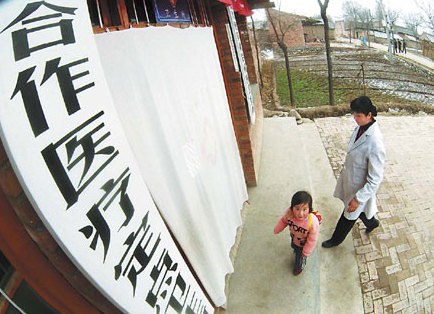When 45-year-old Wang Xiuzhi fractured her knees working in the fields, she was faced with the daunting option of traveling at least three hours by bus to hospitals in the city. Treatment there was guaranteed to be expensive for farmers like her.
So she decided to undergo an operation in Yangli township near her village instead.
"It's now much more convenient to be treated near my home," Wang told China Daily last month. "We don't want to visit the big hospitals in the city because they are really far away and more expensive."
Wang's choice would not have been so obvious in the past.
|

|
|
A girl, accompanied by a healthcare worker, enters a rural cooperative clinic in Linxia, Gansu province, on November 11, 2008. [Cao Zhizheng]
|
Farmers in the country's rural areas usually seek medical treatment at small village clinics, which are often equipped to deal with simple ailments such as fevers and cuts. "Barefoot doctors" with rudimentary medical knowledge were the only ones at hand to treat patients.
The village clinics, part of a healthcare system set up in the 1950s, have proven to be successful in providing basic healthcare in the country's poverty-stricken areas. But in recent years, poor pay and lack of social insurance have driven away many village doctors, making it even harder for farmers to get basic medical care.
If the farmers got very sick, they had to go to township clinics or the hospitals in the city.
Yangli township's clinic, built in 1956, used to be poorly equipped and could only provide simple medical treatment. Villagers such as Wang with serious fractures would have probably received inadequate treatment at such town clinics.
A government initiative to improve medical facilities in rural areas is changing all that.
Last year, the local authorities poured 13 million yuan ($1.9 million) to build a new and fully equipped clinic for the town, which covers 52 villages and 580,000 people. Under a cooperation agreement, dozens of medical professionals from the Laicheng People's Hospital have also been regularly stationed at the clinic to help improve its management and medical treatment.
Wang saved time and money at the clinic, undergoing a 12-day medical treatment costing 2,743 yuan.
"This kind of treatment will cost at least 5,000 yuan at the big hospitals in the city," said Wei Lanjie, the deputy director of the local clinic. "According to our new rural cooperative medical scheme, funds will cover 45 percent of patients' medical expenses if they are hospitalized in the town clinic, compared with 36 percent for the same treatment in the city hospital."
Under current policy, the country's urban areas receive 80 percent of medical resources. This leaves 800 million farmers, the majority of the 1.3 billion population, with huge challenges in accessing adequate health and medical facilities, former health minister Gao Qiang said at a national conference on hospital development in 2006. The uneven allocation of medical resources between those in the urban and rural areas was one of the biggest obstacles for carrying out medical reform, he said.
A national health and medical reform draft released on Oct 14 sought to solicit public opinion to improve healthcare, with one major area aimed at providing equal medical services to rural and urban residents. It called for the building up of a village-town-county medical service network in rural areas and encouraged local governments in a number of wealthy regions to take innovative measures to improve rural medical facilities.